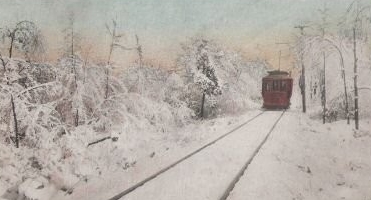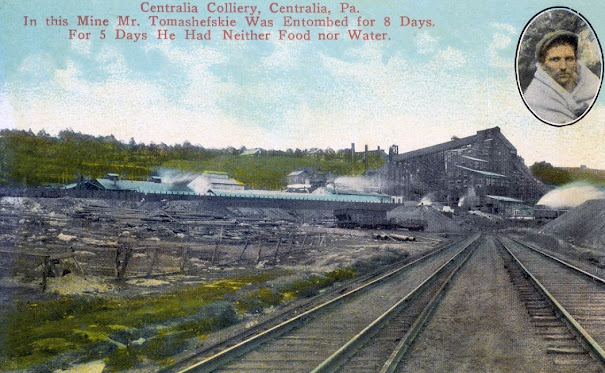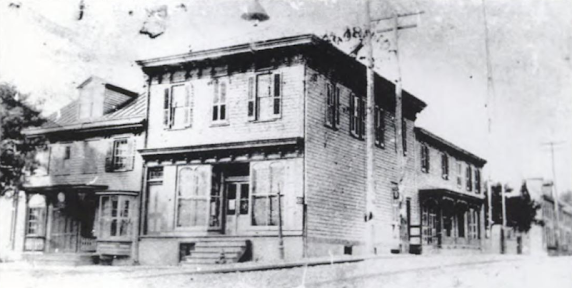It's hard to believe, but this is what Centralia looked like in 1966. The fires had been burning for 4 years, but no one suspected that in less than 20 years time, all of these buildings would be torn down.
The History Of Centralia - A Coal Mining Town
Centralia in 1906. Most of the homes razed in the early 1980s were more than 100 years old.
During the 1860's, the Molly Maguires were active in the Centralia area.
In 1868, Alexander Rae, the towns founder and president of the Locust Mountain Coal and Iron Co, was murdered in his buggy. The three men convicted for his murder, all named as Molly Maguires, were hung in Bloomsburg. They were the only convicted criminals to ever be hung in Columbia County. Several other murders and arson plagued the town, all being credited to the Mollies. The Centralia House Hotel operated between 1865 & 1937
The proprietor, William Hepner, was murdered in the tavern here in 1896
(Hepner was shot by Mike Corrigan in May of 1896)
1906 "Birds Eye" view of Centralia, looking towards the 1st St Ignatius church, the steeple of which can just barely be made out at the top middle of the photo.
Centralia's First Fire Company, Centralia Hose Co, 1895
President James Davis shown sitting in the horse drawn hose cart
In 1908, an above ground fire destroyed 40 homes and businesses and left 170 people homeless.
Dykes Hotel, Centralia PA about 1910
This hotel became a Veterans Facility in the town.
Centralia in 1913. A Trolley line (tracks shown here) ran between Centralia and Mt Carmel.
August 1911
Postcard depicting the trolley line between Centralia and Mt Caramel, Pa.
Ashland & Centralia Trolley Car
Thomas Tomasheffski was trapped in a mine at Centralia for 8 days in October of 1913. Not only did he survive, without food or water, but it was the second time he had been trapped in a mine.
The Mamoth Store, located on North Locust Avenue
The Company Store of the Lehigh Valley Coal Company
General Store, corner of Locust Avenue & Railroad Street Centralia PA
Built in 1865, Operated by Millard & Shuman
St Peter & Paul Russian Orthodox Church
This church lost it's classic domes in Hurricane Hazel, 1954. The church stood until 1986.
Other Churches:
First United Methodist (1863-1985),
Holy Trinity Episcopal (1866-1966)
Presbyterian (1867-1954)
St. Ignatius Roman Catholic (1869-1995)
First English Baptist (1887-1917)
St. Peter and Paul Russian Orthodox (1916-1986 )
St Ignatius Parochial School, 1915
Centralia High School, 1913
Centralias Public School was built in 1885. It was destroyed by fire in 1935, with a new school, The Hubert Eicher School, built in 1937.
The Centralia School merged with the Mount Caramel School District in 1963.
The Eicher School was later sold to K-9 Furniture World.
1907 photo of the Lehigh Valley Breaker in Centralia
In 1929, the stock market crashed. The Lehigh Valley Coal Company closed 5 of the mines it operated in the Centralia area, as the Great Depression began.
Centralia in the early 1980s
In the spring of 1962, The borough had fallen behind, and had not yet completed the federally mandated fire resistant clay barrier between each layer of the landfill.
That May, a trash hauler dumped a load of hot ash into an open trash pit at the landfill. With the barrier not completed, coals were able to penetrate the vein of coal underneath the pit and start the subsequent subterranean fire.
Or at least that is one authors theory. But the very next day, on May 27th, members of the fire company set the dump on fire themselves. This was something that was done periodically, a controlled burn to clean up the landfill. This time however, an unsealed opening may have allowed the fire to enter the coal vein below.
Either way, the fire began at the landfill, and at the time it occurred, it didn't seem to be an especially large concern.
The fire is largely unmentioned in local newspapers, until 3 months later, in August of 1962. By then, carbon monoxide fumes, from the fire, were accumulating in the mines. State mining officials closed down approximately 44 mining operations in the vicinity.
An article in the Daily Item on August 25 1962 stated that The Bridy Contracting Company of Atlas had begun the task of extinguishing the fire. They had hoped to isolate, and then extinguish, the fire in the area of the Odd Fellows Cemetery & St Ignatius Church. The State mining inspection revealed that all of the old workings were interconnected, and the toxic fumes were in practically all of the mining operations in the area.

From 1962 through 1978, millions of dollars were spent trying to control the fire with limited results, and no real success.
U.S. Bureau of Mines' John Stockalis, right, and Dan Lewis drop a thermometer through a hole on Main Street in Centralia, Pennsylvania on April 2, 1981, to measure the temperature underground.
In 1982, The Fire Comes To The Surface
"After 19 years of huffing and puffing, the underground mine fire here has shown it's face - and a local fireman yesterday said it was spectacular"
The Pittsburgh Post Gazette, July 24 1981
A patch of fire broke through the surface and started a small brush fire about a mile and a half outside of town. Smoke had been rising from the area for six months - since February.
The fire burned in a gully, with flames in a 10 foot area.
The "Vapors" and above ground fires, like the houses that once stood here, are no longer seen. The fires are still burning, but they are now deeper underground.
When I was a teenager, groups of us would make the drive to see the town that was on fire. Houses still lined the roads then, and vapors and flames could be spotted coming out of the ground.
In the 1980s, a thousand people still inhabited the town. All real estate in the borough was claimed under eminent domain in 1992 and the town was condemned. The Post office discontinued Centralia's ZIP code in 2002.
State and local officials reached an agreement with the seven remaining residents on October 29, 2013, allowing them to live out their lives there, after which the rights to their houses will be taken through eminent domain. By 2017, only 5 residents remained.
Almost all of the houses are gone now, and the lots are grown over.
Today, the town is used by ATV riders, who take advantage of the empty roads and lots.
The Ukranian Catholic Church still stands on the hill in Centralia
When the fire began, Centralia had five churches. One by one, they disappeared, and the Catholic Ukranian Church almost followed. But Archbishop Stephen Sulyk ordered a survey under the church. The survey shows that the church sits not on coal, but on solid rock. And so it was allowed to remain.
Graffiti Highway - Now Covered By Dirt
A section of PA 61 south of Centralia was closed in 1993 after the Centralia mine fire damaged the road and made it unsafe to travel on; this section was bypassed with a realignment to a parallel road through Byrnesville. This section of damaged, closed, road is now known as Graffiti Hightway.
GPS Coords For Graffiti Highway - 40.799357, -76.339553
===============
===============
This 30 minute documentary from 1982 aired on PBS. Narrated by Martin Sheen, it shows the town as it was before it was evacuated - with stores, and homes, and traffic. It's a shocking contrast to the deserted overgrown areas left today.
- St Ignatius Church
- More About the Coal Mining Practice Of Robbing The Pillars
- The Town That Was Documentary, For Rent on Amazon
- Centralia Pa - Images Of America Book
- Fire Underground: The Ongoing Tragedy Of The Centralia Mine Fire by David Dekock
=====================
August 1911












































No comments:
Post a Comment
I'll read the comments and approve them to post as soon as I can! Thanks for stopping by!